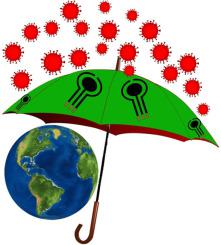Science of the Total Environment ( IF 8.2 ) Pub Date : 2020-09-16 , DOI: 10.1016/j.scitotenv.2020.142363 Manish Srivastava 1 , Neha Srivastava 1 , P K Mishra 1 , Bansi D Malhotra 2

|
We are currently facing the COVID-19 pandemic which is the consequence of severe acute respiratory syndrome coronavirus (SARS-CoV-2). Since no specific vaccines or drugs have been developed till date for the treatment of SARS-CoV-2 infection, early diagnosis is essential to further combat this pandemic. In this context, the reliable, rapid, and low-cost technique for SARS-CoV-2 diagnosis is currently the foremost priority. At present reverse transcription polymerase chain reaction (RT-PCR) is the reference technique presently being used for the detection of SARS-CoV-2 infection. However, in a number of cases, false results have been noticed in COVID-19 diagnosis. To develop advanced techniques, researchers are continuously working and in the series of constant efforts, nanomaterials-enabled biosensing approaches can be a hope to offer novel techniques that may perhaps meet the current demand of fast and early diagnosis of COVID-19 cases. This paper provides an overview of the COVID-19 pandemic and nanomaterials enabled biosensing approaches that have been recently reported for the diagnosis of SARS-CoV-2. Though limited studies on the development of nanomaterials enabled biosensing techniques for the diagnosis of SARS-CoV-2 have been reported, this review summarizes nanomaterials mediated improved biosensing strategies and the possible mechanisms that may be responsible for the diagnosis of the COVID-19 disease. It is reviewed that nanomaterials e.g. gold nanostructures, lanthanide-doped polysterene nanoparticles (NPs), graphene and iron oxide NPs can be potentially used to develop advanced techniques offered by colorimetric, amperometric, impedimetric, fluorescence, and optomagnetic based biosensing of SARS-CoV-2. Finally, critical issues that are likely to accelerate the development of nanomaterials enabled biosensing for SARS-CoV-2 infection have been discussed in detail. This review may serve a guide for the development of advanced techniques for nanomaterials enabled biosensing to fulfill the present demand of low-cost, rapid and early diagnosis of COVID-19 infection.
中文翻译:

用于 COVID-19 检测的纳米材料生物传感器的前景
我们目前正面临由严重急性呼吸综合征冠状病毒 (SARS-CoV-2) 引起的新冠肺炎 (COVID-19) 大流行。由于迄今为止尚未开发出治疗 SARS-CoV-2 感染的特异性疫苗或药物,因此早期诊断对于进一步抗击这一流行病至关重要。在这种背景下,可靠、快速、低成本的 SARS-CoV-2 诊断技术是当前的首要任务。目前,逆转录聚合酶链反应(RT-PCR)是目前用于检测 SARS-CoV-2 感染的参考技术。然而,在许多情况下,COVID-19 诊断中发现了错误结果。为了开发先进技术,研究人员正在不断努力,在一系列不断的努力中,纳米材料支持的生物传感方法有望提供新颖的技术,或许可以满足当前快速、早期诊断 COVID-19 病例的需求。本文概述了 COVID-19 大流行和最近报道的用于诊断 SARS-CoV-2 的纳米材料生物传感方法。尽管关于纳米材料开发用于诊断 SARS-CoV-2 的生物传感技术的研究有限,但本综述总结了纳米材料介导的改进的生物传感策略以及可能负责诊断 COVID-19 疾病的可能机制。据评论,纳米材料,例如金纳米结构、稀土掺杂的聚苯乙烯纳米颗粒(NP)、石墨烯和氧化铁纳米颗粒,可用于开发基于 SARS-CoV 的比色、电流、阻抗、荧光和光磁生物传感的先进技术。 2. 最后,详细讨论了可能加速 SARS-CoV-2 感染生物传感纳米材料开发的关键问题。本综述可以为纳米材料生物传感先进技术的开发提供指导,以满足当前低成本、快速和早期诊断 COVID-19 感染的需求。











































 京公网安备 11010802027423号
京公网安备 11010802027423号